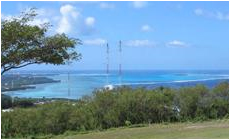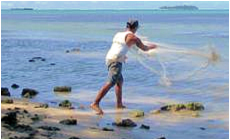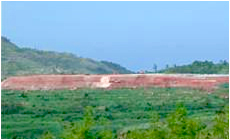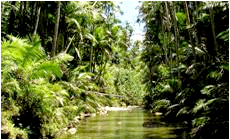WATER QUALITY, PRODUCTION AND DISTRIBUTION
Although the islands of the western Pacific are relatively isolated from pollutants generated by the industrialized nations of the world, many are experiencing self imposed environmental degradation as a result of increased population growth and commercial development. Past and present military activities have also contributed significantly to disturbances in environmental quality on several islands, particularly Guam and Saipan. While some research has been directed towards evaluating the extent of such disturbance on terrestrial communities, relatively little attention has been directed towards identifying the impact of key contaminants, like heavy metals, PCBs and PAHs on the coastal waters of these island´s and their marine resources traditionally harvested for food by local inhabitants.
Mindful of such data deficiencies, WERI initiated a research program in 1997 to monitor the distribution and abundance of heavy metals, PCBs and polycyclic aromatic hydrocarbons four harbor locations in Guam. These environments were selected for study because of the diversity of ongoing anthropogenic activities occurring in and around them. They thus represented environments where worst-case scenario conditions would likely prevail. The program initially focused on surface sediments in order to identify potential hot-spots and delineate areas of contamination. Subsequently, an assemblage of biotic representatives were examined to determine contaminant mobilization rates into dominant ecosystem representatives, especially edible species and those with known or suspected bioindicator capability.

In 1999, a similar study was established for Tanapag Lagoon on the western shore of central Saipan. This large lagoon is heavily impacted by the activities of man including a major seaport and bulk fuel facility, a sewer outfall, and a municipal dump. The area is also heavily inundated by stormwater runoff during prolonged periods of wet weather. Contaminant profiles in surface sediments have been mapped and levels in dominant ecological representatives, including edible and potentially useful bioindicator species are currently being assessed. A major study of mercury, arsenic and PCBs in food fishes from within the lagoon is now complete and is being evaluated to determine potential health risks, if any, to local consumers.
Pollution monitoring and assessment studies in Saipan are currently focused on delineating a mercury hotspot in the northern section of Garapan Lagoon. This lagoon lies immediately to the south of Tanapag Lagoon and is impacted largely by urban runoff. Soil from drainage basins within the Garapan area and sediments from the coastal belt are being analyzed in an attempt to locate the source of contamination and identify drainage pathways into the lagoon. Biotic representatives from this popular fishing spot are also being considered.
Back to top ^
In Guam, a recently completed study determined the impact of a municipal dump on the fisheries resources of Pago Bay on the western side of the island. This dump has been in continuous use for over 50 years and has been operating at over capacity for the last 20. The western borders of the dump encroach on wetlands that drain into the Lonfit River. This rather picturesque stream converges with the Sigua River further downstream to form the Pago River, which in turn drains into Pago Bay on the eastern side of the island. Local residents fish all three rivers and the bay for food, and the adjacent lands support a variety of agricultural activities including subsistence farming. Unlike modern landfills, the dump is unlined and does not have a leachate retention system in place. As a result, streams of brown, foul smelling leachate flow intermittently from the dump´s perimeter during wet weather conditions and course their way down gradient into the Lonfit River valley below.
Back to top ^
Past chemical characterization of the leachate indicates that heavy metals are the contaminants of primary concern both from an ecological and human health perspective. This fact has promoted speculation that fisheries resources from these waters are heavy metal enriched to the point of being unfit for human consumption. In light of this, recent chemical analyses of abiotic and biotic components from the rivers and bay were surprising and indicate that local topographic and climatic conditions continually conspire to produce natural cleansing processes that prevent heavy metal accumulation from occurring within the watershed.
WERI´s involvement in pollution monitoring throughout the region is intended to be ongoing and is specifically designed to produce data of value to those involved with environmental protection and resource management. For further information on the Pollution Monitoring and Assessment Program send an email to Dr. Gary R.W. Denton: gdenton(weri)uguam.uog.edu?subject=Pollution Monitoring and Assessment Program - WeriGuam.org
Back to top ^











